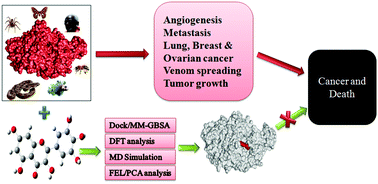Sequence diversity and ligand-induced structural rearrangements of viper hyaluronidase†
Abstract
Hyaluronidases (Hyals) are a class of carbohydrate-active enzyme involved in angiogenesis, cancer proliferation, tumour growth and venom spreading. Functionally significant Hyals are responsible for the fast spreading of venom to the target site of action. The absence of molecular diversity and the structural and functional behaviour of snake venom Hyals was the inspiration for the objective of this study. Echis pyramidum leakeyi hyaluronidase (EHY)-based phylogenetic analysis showed the existence of two functional groups of Hyals which had diverged from the coral snake (the ancestor). The structure was modelled and it was found that the E-loop region (211–224 AA) was only present in EHY compared to the templates which may account for the significant function of viper Hyal. The best interacting ligands were screened from the selected plant derivatives and MYR consisted of better pharmacophore features (AADDRRR) in comparison with other ligands. Furthermore, the HOMO, LUMO, and MO energies and energy gaps of CGA, MIM and MYR were calculated by DFT analysis. EHY–ligand complex stability and interactions were investigated through MD simulation and FEL analysis. These revealed that MIM and MYR or their derivative compounds could be prominent lead molecules for both EHY and other eukaryotic Hyals. PCA analysis of both the non-ligated and ligated forms confirmed that loop-III (86–96 AA) and E-loop region structural rearrangements were essential for the association and dissociation process of the substrate. Particularly, ARG92 and LYS219 are determined as important key residues from the conformational changes. These regions’ dynamic behaviour can be associated with HA binding and the catalytic function of EHY. This result can extend our knowledge of viper Hyal functional behaviour and provides structural insight to target eukaryotic Hyals as forthcoming drug targets in cancer treatment and venom spreading.


 Please wait while we load your content...
Please wait while we load your content...